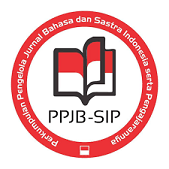PENGGUNAAN METODE PROBLEM SOLVING OLEH GURU BAHASA INDONESIA DALAM PEMBELAJARAN DEBAT DI KELAS X SMA NEGERI 1 SAWAN
DOI:
https://doi.org/10.23887/jjpbs.v7i2.14489Abstract
Penelitian ini bertujuan untuk mendeskripsikan (1) penggunaan metode problem solving oleh guru bahasa Indonesia dalam pembelajaran debat di kelas X (2) respons siswa terhadap penggunaan metode problem solving oleh guru bahasa Indonesia dalam pembelajaran debat di kelas X (3) kendala guru yang datang dari siswa dalam penggunaan metode problem solving pada pembelajaran debat di kelas X SMA Negeri 1 Sawan. Penelitian ini menggunakan rancangan penelitian deskriptif kualitatif. Subjek penelitian ini adalah guru dan siswa. Objek dalam penelitian ini adalah penggunaan metode problem solving, respons siswa, dan kendala guru. Metode pengumpulan data yang digunakan adalah metode observasi dan metode wawancara. Data dalam penelitian ini dianalisis secara deskriptif kualitatif. Hasil penelitian ini ialah (1) penggunaan metode problem solving dalam pembelajaran debat telah memenuhi prosedur, yaitu pada awal pembelajaran guru mampu mengarahkan siswa, pada inti pembelajaran siswa mampu mengikuti debat dengan maksimal, dan pada akhir pembelajaran siswa memperoleh gambaran mengenai metode problem solving dalam debat. (2) respons siswa sebagian besar positif, yakni menyenangi penuh metode problem solving, namun sebagian kecil kurang menyenangi metode problem solving. (3) kendala guru adalah dari segi siswa dan fasilitas. Simpulan penelitian ini adalah (1) penggunaan metode problem solving telah efektif dan sesuai prosedur. (2) respons siswa sebagian besar positif. (3) kendala yang ditemukan oleh guru adalah dari segi siswa dan fasilitas sekolah yang sangat terbatas. Saran penelitian ini ialah, guru Bahasa Indonesia agar mempertahankan keefektifan pembelajaran dan lebih memotivasi siswa, serta untuk pihak sekolah lebih meningkatkan fasilitas pembelajaran.Kata Kunci : debat, pembelajaran, problem solving.
This study aimed for describing:1) the use of problem solving method by Indonesian teacher in debate in 10th grade students 2) students response towards the use of problem solving method by Indonesian teacher in debate in 10th grade students, 3) the teachers obstacle about the use of problem solving method by Indonesian teacher in debate in 10th grade students of SMA Negeri 1 Sawan. This study used descriptive qualitative design. The subjects of this study are the teacher and the students. The objects of this study are the use of the method, students response and the teacher’s obstacle. This study used several methods such as observation and interview. The data was analyzed by using descriptive qualitative. The result showed that: 1) the use of problem solving method has fulfilled the procedure, in the beginning the teacher can guide the students, in the middle of the learning process the students can follow the debating activity maximally, in the end the students knew about the problem solving method in debate, 2) the students response are dominantly positive towards problem solving method, 3) the teacher’s obstacle are students and facilities. The conclusions of this study are: 1) the use of problem solving method was effective and fulfilled the procedure, 2) 2) the students response are dominantly positive, 3) the teacher’s obstacle are the students and the facilities in the school. This study suggested that Indonesian teacher to keep the effectiveness of the learning and motivate the students then for the school staff to improve the facility.
keyword : debate, lesson, problem solving
Published
2018-07-05
Issue
Section
Articles
License
Authors who publish with the Jurnal Pendidikan Bahasa dan Sastra Indonesia Undiksha agree to the following terms:- Authors retain copyright and grant the journal the right of first publication with the work simultaneously licensed under a Creative Commons Attribution License (CC BY-SA 4.0) that allows others to share the work with an acknowledgment of the work's authorship and initial publication in this journal
- Authors are able to enter into separate, additional contractual arrangements for the non-exclusive distribution of the journal's published version of the work (e.g., post it to an institutional repository or publish it in a book), with an acknowledgment of its initial publication in this journal.
- Authors are permitted and encouraged to post their work online (e.g., in institutional repositories or on their website) prior to and during the submission process, as it can lead to productive exchanges, as well as earlier and greater citation of published work. (See The Effect of Open Access)







